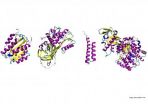Rehabilitation therapies can lead to recovery from chronic fatigue syndrome
2013-01-31
(Press-News.org) Research led by Queen Mary, University of London, has shown that recovery from chronic fatigue syndrome (CFS) is possible for some patients, and has identified two treatments most likely to lead to recovery.
The latest results from the PACE trial* show that cognitive behaviour therapy (CBT) and graded exercise therapy (GET), as supplements to specialist medical care, increase the likelihood of recovery from CFS three-fold compared to other treatments studied. The trial, carried out in collaboration with researchers from King's College London, the University of Oxford and the Medical Research Council (MRC), is published today in Psychological Medicine.
CFS is a long-term and debilitating condition that affects around 250,000 people in the UK. Symptoms include profound physical and mental fatigue (characteristically made worse by exertion), muscle and joint pain, disturbed sleep and both concentration and memory problems. The researchers studied 640 participants with CFS who were randomised into one of four treatment groups:
Specialist medical care (SMC) alone;
SMC plus adaptive pacing therapy (APT);
SMC plus cognitive behavioural therapy (CBT);
SMC plus graded exercise therapy (GET)
Evidence for recovery was assessed one year after participants were randomly allocated to treatments.
Previous published results showed that both CBT and GET led to greater reductions in symptoms and disability than either APT or SMC. In this analysis the researchers have gone a step further and examined how many patients had recovered from their illness after these treatments. Patients were classed as recovered if they no longer met several criteria for ill health which were initially used to define eligibility for the trial. These included not suffering from significant fatigue or physical disability, and no longer meeting diagnostic criteria for CFS. Patients also had to rate themselves as being "much" or "very much better" in their overall health.
The findings showed that those who received CBT or GET, in addition to SMC, were three times more likely to meet the criteria for recovery than those receiving SMC alone or in combination with APT. Overall 22 per cent of those who received either CBT or GET, in addition to SMC, met the criteria for recovery, compared to eight per cent after APT in addition to SMC, and seven per cent after SMC alone. There were similar patterns of recovery however CFS was defined, including those who were diagnosed as having myalgic encephalomyelitis (ME), thought by some to be the same as CFS and by others as being different.
Peter White, Professor of Psychological Medicine at Barts and the London School of Medicine and Dentistry, part of Queen Mary, was the lead co-principal investigator of the PACE trial and co-author of the latest paper.
Professor White said: "This is good news and shows that recovery from this debilitating condition is possible for some patients. We now need to go further to understand why only a relatively small proportion of patients recover, which shows how much this condition varies between individuals; one treatment is unlikely to work for everyone.
"Some people may question the use of the term 'recovery', and how to define when a patient is 'recovered' was a key issue we faced. We focussed on recovery from the current episode of the illness and used several measures of both symptoms and disability to give us the most complete picture possible. Further analysis is needed to see if recovery is sustained in the long-term."
Professor Michael Sharpe, University of Oxford co-principal investigator of the PACE trial and co-author of the latest paper, said: "The rehabilitative treatments of CBT and GET for CFS have been controversial. This analysis of the PACE trial data shows that not only do they achieve improvements in the majority, but that they can also lead to recovery in a substantial minority."
Professor Trudie Chalder from King's College London's Institute of Psychiatry, said: "The fact that people can recover from chronic fatigue syndrome is excellent news. Healthcare professionals can now be more confident in sharing this possibility with patients, many of whom are understandably concerned about their future."
INFORMATION: END
ELSE PRESS RELEASES FROM THIS DATE:
2013-01-31
Simple 'blast' fences called baffles could deliver improvements in air quality for people living near airports, new research has found.
Placed behind a runway, the baffles could serve as a 'virtual chimney', funnelling emissions from aircraft engines upwards where they can disperse more effectively, thereby reducing the environmental impact on people living nearby.
Prototype baffles have been tested by a team of researchers from Manchester Metropolitan University, Cranfield University, University of Southampton and the University of Cambridge, with funding from the ...
2013-01-31
Philadelphia, PA, January 31, 2013 – Disulfiram was the first medication approved for the treatment of alcoholism over 50 years ago. It works, at least in part, by preventing the metabolism of an alcohol by-product, acetaldehyde. High levels of acetaldehyde in the body quickly cause unpleasant symptoms, including nausea, vomiting, headache, and accelerated heart rate. Thus, disulfiram provides a very strong incentive to avoid drinking.
Beginning in the late 1990s, a series of studies conducted at Yale University found that disulfiram reduced the consumption of cocaine, ...
2013-01-31
Proteins are elementary building blocks of life. They often perform vital functions. In order to become active, proteins have to fold into three-dimensional structures. Misfolding of proteins leads to diseases such as Alzheimer's or Creutzfeld-Jakob. So which strategies did nature develop over the course of evolution to improve protein folding?
To examine this question, the chemist Dr. Frauke Gräter (Heidelberg Institute for Theoretical Studies) looked far back into the history of the Earth. Together with her colleague Prof. Gustavo Caetano-Anolles at the University of ...
2013-01-31
A recent discovery funded by the Air Force Office of Scientific Research (AFOSR) may very well lead to a process that not only benefits every uniformed service member of the Department of Defense, but everyone else as well: protection from Chemical/Biological agents, to self-cleaning apparel, to effortless thermal management, to fuel purification as well as enhanced control of leaks—especially oil and fuels.
In 2006, AFOSR Program Manager Dr. Charles Lee funded Professor Gareth McKinley at the Massachusetts Institute of Technology exploring nanocomposite technology ...
2013-01-31
OAK BROOK, Ill. (January 31, 2013) – Researchers using a newly approved advanced computed tomography (CT) system were able to significantly reduce radiation exposure in patients undergoing coronary CT angiography (CCTA), according to a new study published online in the journal Radiology.
"Radiation exposure during diagnostic imaging is a substantial public concern," said Marcus Y. Chen, M.D., lead author of the study from the advanced cardiovascular imaging laboratory at the National Institutes of Health in Bethesda, Md. "Minimizing radiation exposure while maintaining ...
2013-01-31
This press release is available in Spanish.
Corn crop residues are often left on harvested fields to protect soil quality, but they could become an important raw material in cellulosic ethanol production. U.S. Department of Agriculture (USDA) research indicates that soil quality would not decline if post-harvest corn cob residues were removed from fields.
This work, led by Agricultural Research Service (ARS) soil scientist Brian Wienhold, supports the USDA priority of developing new sources of bioenergy. ARS is USDA's chief intramural scientific research agency.
Wienhold ...
2013-01-31
Texas Biomed scientists in San Antonio have found that moderate gum disease in an animal model exposed to an AIDS- like virus had more viral variants causing infection and greater inflammation. Both of these features have potential negative implications in long term disease progression, including other kinds of infections, the researchers say in a new report.
The public health message from the study is that even mild inflammation in the mouth needs to be controlled because it can lead to more serious consequences, said Luis Giavedoni, Ph. D, a Texas Biomed virologist and ...
2013-01-31
It would be a terrible thing if laboratories striving to grow graphene from carbon atoms kept winding up with big pesky diamonds.
"That would be trouble, cleaning out the diamonds so you could do some real work," said Rice University theoretical physicist Boris Yakobson, chuckling at the absurd image.
Yet something like that keeps happening to experimentalists working to grow two-dimensional boron. Boron atoms have a strong preference to clump into three-dimensional shapes rather than assemble into pristine single-atom sheets, like carbon does when it becomes graphene. ...
2013-01-31
Recent natural disasters illustrate vulnerability of older people: majority of deaths from the Great East Japan Earthquake (2011) and Hurricane Katrina (2005) occurred among older people.
Researchers at the Stockholm Environment Institute at the University of York and Simon Fraser University's Gerontology Research Centre in Canada are calling for better awareness among policy makers and the public of the impact climate change and deteriorating environmental quality will have on an ageing population.
According to UN projections, by 2050, nearly 25 per cent of the global ...
2013-01-31
CHAPEL HILL, N.C. – In the last decade, a new strain of MRSA has emerged that can spread beyond hospital walls, putting everyone at risk of contracting the dangerous bacterial infection. This particular strain of MRSA – known as USA300 – contains a chunk of genes not shared by any other strains, though it is unclear how this unique genetic material enables the bacteria to survive and persist in the community.
Now, research from the University of North Carolina School of Medicine has pinpointed a gene that causes the infection to linger on the skin longer than other strains, ...
LAST 30 PRESS RELEASES:
[Press-News.org] Rehabilitation therapies can lead to recovery from chronic fatigue syndrome

